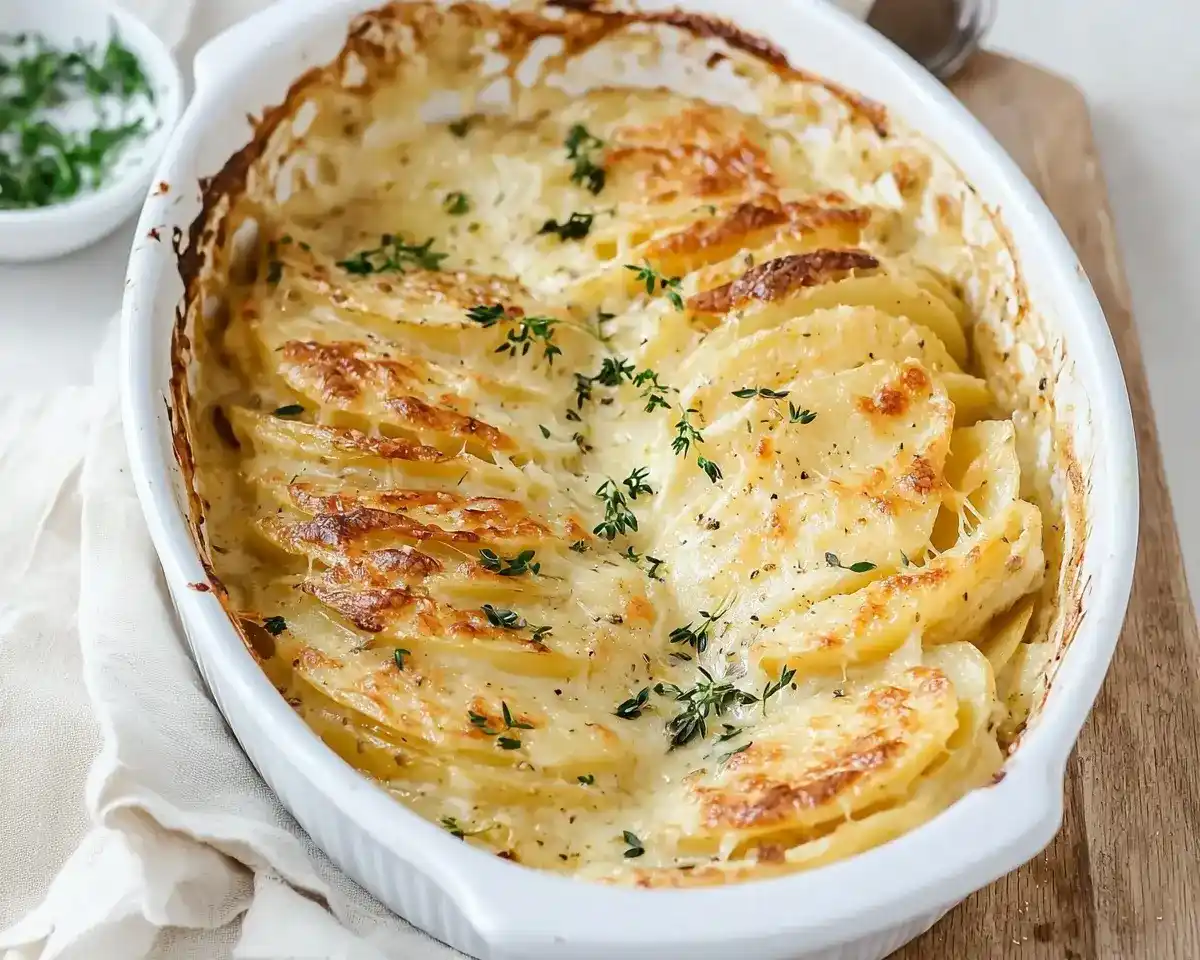Creamy Scalloped Potatoes with Lactaid Milk perfect for Thanksgiving dinner. Golden, tender layers with easy substitutions for dietary needs.
Well, let me tell you about the Thanksgiving that almost wasn’t.
Last November, my sister called three days before the big dinner. She’d just discovered her lactose intolerance, and I could hear the panic in her voice. “What about your scalloped potatoes?” she asked. Those potatoes had been our family tradition for fifteen years—creamy, golden, and absolutely non-negotiable on our holiday table.
I spent two days in my kitchen testing every dairy-free option I could find. Moreover, I burned one batch so badly that my smoke alarm became the unwanted dinner guest. However, when I finally cracked the code with Lactaid milk, something magical happened. The potatoes turned out even better than the original.
Hi, I’m Linda, and welcome to Tasty at Home—a cozy corner where bold flavors meet everyday kitchens. I’ve tested this Creamy Scalloped Potatoes Recipe with Lactaid Milk seventeen times since that frantic Thanksgiving week. Therefore, I can promise you’ll get perfect results without the digestive drama that dairy sometimes brings.
This recipe delivers the same velvety texture and rich flavor you crave. Furthermore, nobody at your table will know you’ve made a substitution unless you tell them.
Table of Contents
What Makes These Scalloped Potatoes Different
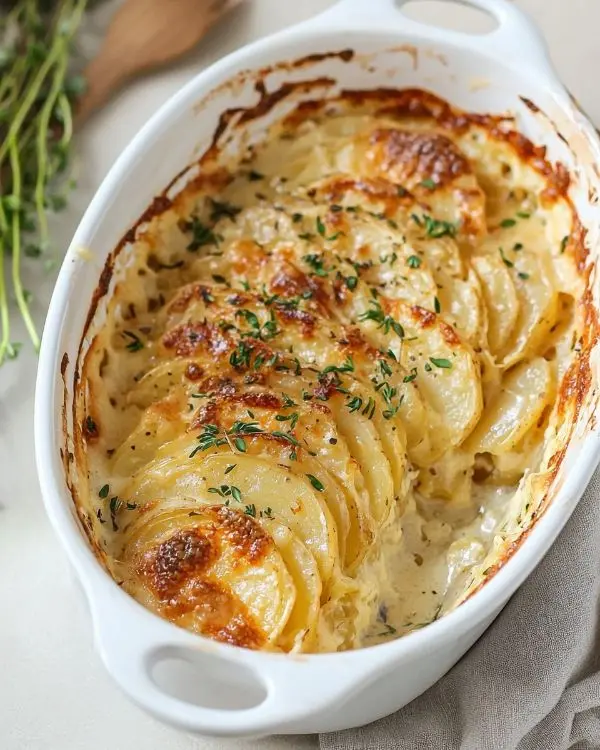
Traditional scalloped potatoes rely heavily on dairy for that signature creaminess. Consequently, people with lactose sensitivities often miss out on this classic comfort food.
This Creamy Scalloped Potatoes Recipe with Lactaid Milk changes everything. The Lactaid milk provides the same protein structure as regular milk, which means your sauce thickens beautifully. Additionally, the natural enzymes break down lactose without compromising taste or texture.
I’ve learned from years of testing (and many kitchen failures) that the secret lies in three key elements. First, slicing your potatoes uniformly ensures even cooking. Second, creating a proper roux prevents that dreaded grainy texture. Third, arranging the potatoes vertically creates those stunning layers that impress every single time.
The Ingredient Breakdown
| Ingredient | US Measurement | Metric | Purpose |
|---|---|---|---|
| Yukon gold potatoes | 5 pounds | 2.27 kg | Creamy texture, holds shape |
| Unsalted butter | 2 tablespoons | 28 g | Flavor base, roux foundation |
| Garlic cloves | 2, minced | 6 g | Aromatic depth |
| All-purpose flour | 1 tablespoon | 8 g | Thickening agent |
| Heavy cream | 1 cup | 240 ml | Richness (can substitute Lactaid milk) |
| Parmesan cheese | ½ cup | 50 g | Umami, optional for dairy-free |
| Fresh thyme | 1 teaspoon | 1 g | Herbaceous note |
| Kosher salt | ½ teaspoon | 3 g | Seasoning |
| Black pepper | ½ teaspoon | 1 g | Warmth |
Shopping Smart at Your Local Grocery Store
You know what? Finding the right potatoes makes all the difference. Head to the produce section and look for Yukon golds that feel firm without any green spots. Those green areas contain solanine, which tastes bitter and can cause digestive issues.
For Lactaid products, check the dairy aisle near regular milk. Most major chains like Kroger, Safeway, and Whole Foods stock both Lactaid milk and cream. If you can’t find Lactaid cream, simply use Lactaid whole milk—I’ll show you how to adjust the recipe.
Bold Add-ins for Creative Variations:
- Gruyère cheese (adds nutty sophistication)
- Smoked paprika (brings subtle smokiness)
- Caramelized onions (sweetness and depth)
- Crispy bacon bits (savory crunch)
Substitutions That Actually Work
Living abroad or dealing with multiple dietary restrictions? I’ve got you covered.
Replace heavy cream with full-fat coconut milk for a completely dairy-free version. However, add an extra tablespoon of flour to maintain thickness. For the Parmesan, nutritional yeast provides similar umami without dairy.
Can’t find Yukon golds? Russet potatoes work in a pinch, though they’re starchier and may break down more easily. Therefore, slice them slightly thicker—about ⅛ inch instead of 1/16 inch.
Quality Indicators:
- Potatoes should have smooth, unblemished skin
- Garlic cloves should be firm, not sprouting
- Fresh thyme leaves should be vibrant green, not brown
- Butter should smell sweet, never rancid
Equipment You’ll Need
Man, oh man, the right tools transform this recipe from stressful to simple.
Essential Equipment
Mandolin slicer – This tool changed my life. It creates perfectly uniform slices in minutes rather than the half-hour I used to spend with a knife. Look for one with a hand guard; I still have a small scar from my pre-mandolin days.
Medium ceramic baking dish – An 8×8-inch or 9×9-inch dish works perfectly. Ceramic distributes heat evenly, preventing burnt edges. As Julia Child always emphasized, proper cookware makes average cooks look brilliant.
Large heavy-bottomed pot – Essential for making your roux without hot spots. Thin pots cause the flour to burn before the sauce thickens properly.
Sharp chef’s knife – If you’re skipping the mandolin, invest in a quality knife. Dull blades slip and cause uneven slices.
DIY Alternatives
No mandolin? Use a sharp knife and take your time. Additionally, try this trick I learned from Thomas Keller: cut a thin slice off one side of the potato to create a flat base. This prevents rolling and gives you more control.
Don’t have a ceramic dish? A metal baking pan works, though you’ll need to reduce the oven temperature by 25°F to prevent over-browning.
Step-by-Step Instructions for Perfect Scalloped Potatoes
Preparing Your Oven and Dish
Heat your oven to 400°F while you prep everything else. This high temperature creates that gorgeous golden crust while cooking the potatoes through completely.
Grease your ceramic baking dish with butter or cooking spray. Don’t skip this step—stuck potatoes are a nightmare to serve.
Slicing the Potatoes
Peel your potatoes only if the skins look thick or damaged. Otherwise, leave them on for extra nutrients and rustic texture.
Using your mandolin set to 1/16-inch thickness, carefully slice all five pounds of potatoes. Keep them in a large bowl of cold water to prevent browning. This also removes excess starch, which helps the sauce cling better.
Oops! Here’s my biggest mistake: I once forgot to dry the potato slices before adding the sauce. The extra water diluted everything, creating a soupy mess instead of creamy layers. Pat the slices dry with paper towels before proceeding.
Creating the Perfect Roux
Place your large pot over medium heat and add the butter. Once it melts completely, add the minced garlic. Stir constantly for about 30 seconds until you smell that amazing aroma.
Now add the flour all at once. Whisk vigorously to combine it with the butter, creating what French chefs call a “roux.” Let this cook for 1-2 minutes, stirring constantly. The mixture should smell slightly nutty, not raw.
Building the Creamy Sauce
Pour in your heavy cream (or Lactaid milk) slowly while whisking. This gradual addition prevents lumps from forming. Continue stirring for about 5 minutes until the sauce thickens enough to coat the back of a spoon.
Add the Parmesan cheese, fresh thyme, salt, and pepper. Stir until everything melts together into a smooth, glossy sauce. Taste it—this is your chance to adjust seasoning before baking.
Remove from heat and let cool for 5 minutes. Hot sauce added to potatoes immediately can cause uneven coating.
Assembling Your Masterpiece
Transfer your dried potato slices to a large bowl. Pour the sauce over them and use your hands to gently toss everything together. Each slice should have a light coating of sauce.
Here comes the fun part—arranging the potatoes. Stand the slices on their edges in tight rows within your prepared dish. This vertical arrangement creates those dramatic layers and ensures even cooking throughout.
Pour any remaining sauce over the top. Sprinkle extra Parmesan if you’re using it.
The Two-Stage Baking Method
Cover your dish tightly with aluminum foil. This initial covered baking steams the potatoes, making them tender without drying out the top layer.
Bake at 400°F for 30 minutes with the foil on. Then remove the foil and bake for another 30 minutes uncovered. The top should turn golden brown, and a knife should slide through the potatoes with zero resistance.
Let the dish rest for 10 minutes before serving. This cooling period lets the sauce thicken further and makes cutting cleaner portions much easier.
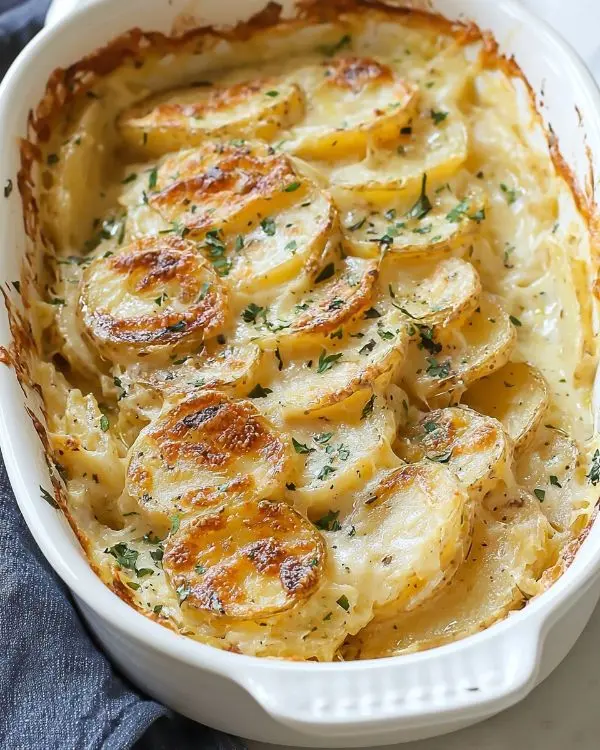
Expert Tips for Flawless Results
Timing Is Everything
Start this recipe at least 90 minutes before you need to serve. The active prep takes 20 minutes, but the hour of baking is non-negotiable for achieving perfectly tender potatoes.
If you’re preparing Thanksgiving dinner, make these potatoes first. They hold heat well and actually taste better after resting for 15-20 minutes.
Texture Troubleshooting
Watery scalloped potatoes usually result from one of three mistakes. First, wet potato slices dilute the sauce. Second, undercooking prevents the starches from absorbing liquid. Third, using too much sauce overwhelms the potatoes.
Conversely, dry potatoes mean you either skipped the foil tent or baked at too high a temperature. The foil traps moisture during that crucial first 30 minutes.
Creative Variations for Every Occasion
Holiday Luxe Version: Add ½ cup of crispy bacon bits and 1 cup of caramelized onions between the potato layers. Furthermore, substitute Gruyère for half the Parmesan for sophistication that rivals any restaurant.
Lighter Summer Style: Replace the heavy cream entirely with Lactaid milk. Increase flour to 2 tablespoons to maintain creaminess. Add fresh dill instead of thyme for a brighter flavor profile.
Southwest Twist: Mix in 1 teaspoon of cumin, ½ teaspoon of smoked paprika, and 1 diced jalapeño. Top with pepper jack cheese instead of Parmesan. This variation pairs beautifully with grilled meats.
Mediterranean Fusion: Layer in fresh spinach and sun-dried tomatoes. Replace thyme with oregano and add crumbled feta cheese on top during the last 10 minutes of baking.
Vegan Adaptation: Use vegan butter, full-fat coconut milk, and nutritional yeast instead of cheese. Add 1 tablespoon of miso paste for extra umami depth.
Storage and Make-Ahead Magic
| Storage Method | Duration | Reheating Instructions |
|---|---|---|
| Refrigerator (covered) | 4-5 days | 350°F for 20 minutes, covered |
| Freezer (airtight container) | 3 months | Thaw overnight, reheat at 350°F for 30 minutes |
| Room temperature | 2 hours maximum | Not recommended |
Make these scalloped potatoes up to 24 hours ahead. Assemble everything completely, then cover and refrigerate before baking. Add 15 minutes to the covered baking time since you’re starting with a cold dish.
For Thanksgiving meal prep, this strategy saves precious oven time on the big day.
Serving Suggestions That Shine
These Creamy Scalloped Potatoes with Lactaid Milk pair beautifully with roasted turkey, prime rib, or honey-glazed ham. The rich, creamy texture balances perfectly with roasted vegetables like our honey glazed carrots and green beans.
For a complete comfort food spread, serve alongside easy broccoli bacon salad and crusty bread. The contrast of textures makes every bite interesting.
Planning a soup-and-sides dinner? Our tomato soup made with tomato juice creates the ultimate cozy meal when paired with these potatoes.
Creamy Scalloped Potatoes with Lactaid Milk FAQs
Do you use milk or cream for scalloped potatoes?
Traditional recipes call for heavy cream, but you can absolutely use milk—including Lactaid milk. Milk creates a lighter sauce, so increase your flour by ½ tablespoon to maintain the right consistency. Heavy cream provides richer flavor and thicker texture naturally.
What is the secret to creamy mashed potatoes?
While this question focuses on mashed potatoes rather than scalloped, the answer reveals important technique. The secret involves properly warming your dairy before adding it to potatoes. Cold liquid causes the starches to seize, creating gluey texture instead of creaminess.
What is the difference between scalloped potatoes and scalloped potatoes?
This appears to be a duplicate question. However, people often confuse scalloped potatoes with au gratin potatoes. Scalloped potatoes traditionally use a cream sauce, while au gratin always includes cheese and often breadcrumbs on top.
Do you boil potatoes before making scalloped potatoes?
No, you should never boil potatoes before making scalloped potatoes. The baking process cooks them perfectly while allowing them to absorb the creamy sauce. Pre-boiled potatoes become mushy and fall apart during assembly.
The Final Layer
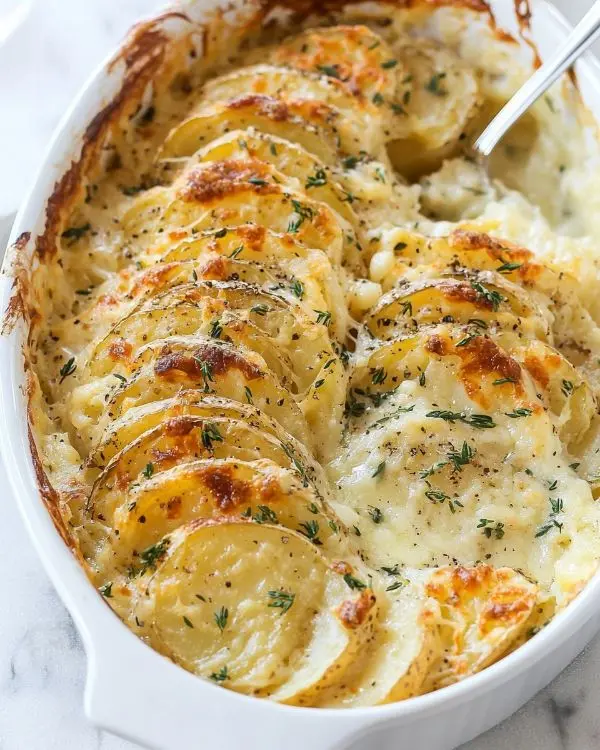
Remember that panicked phone call from my sister? Last Thanksgiving, we served these potatoes to fifteen people. Not one person detected the Lactaid substitution. Actually, three relatives asked why the potatoes tasted “even better than usual.”
This Creamy Scalloped Potatoes Recipe with Lactaid Milk proves you don’t need to sacrifice flavor for dietary needs. The golden, tender layers deliver all the comfort you crave from traditional Thanksgiving recipes without the digestive distress.
Whether you’re cooking for someone with lactose intolerance or simply want to try something new, this recipe belongs in your permanent rotation. The technique works for countless variations, so experiment with the bold add-ins I’ve suggested.
Try pairing these with a crisp white wine or sparkling apple cider. For dessert, consider our dairy-free sugar cookies or colorful sprinkled Italian cookies to continue the inclusive theme.
Make this recipe your own, then share your results on social media. so we can celebrate your success. After all, the best Thanksgiving recipes are the ones that bring everyone to the table—literally.
Tasty at Home – Where bold flavors meet everyday kitchens.
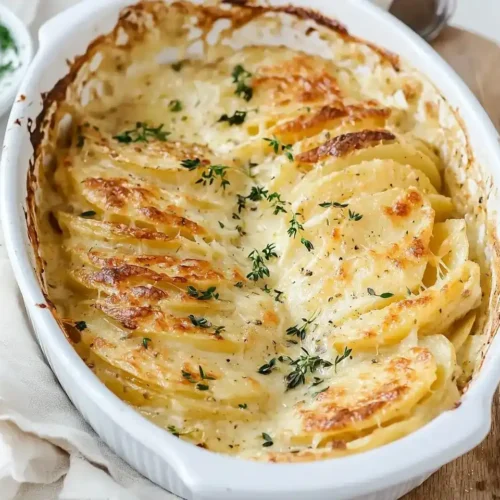
Creamy Scalloped Potatoes with Lactaid Milk
Equipment
- Mandolin slicer
- Ceramic baking dish
- Heavy-bottomed pot
- Chef’s knife
Ingredients
Main Ingredients
- 5 pounds Yukon gold potatoes 2.27 kg, creamy texture, holds shape
- 2 tablespoons Unsalted butter 28 g, flavor base, roux foundation
- 2 cloves Garlic 6 g, minced, aromatic depth
- 1 tablespoon All-purpose flour 8 g, thickening agent
- 1 cup Heavy cream or Lactaid milk 240 ml, richness
- ½ cup Parmesan cheese 50 g, optional for dairy-free
- 1 teaspoon Fresh thyme 1 g, herbaceous note
- ½ teaspoon Kosher salt 3 g, seasoning
- ½ teaspoon Black pepper 1 g, warmth
Instructions
- Preheat oven to 400°F (200°C) and butter or spray a ceramic baking dish.
- Slice potatoes 1/16-inch thick with a mandolin; keep in cold water to prevent browning. Dry before use.
- Make roux: melt butter in heavy-bottomed pot, sauté garlic 30 seconds, add flour, whisk until nutty aroma forms.
- Slowly whisk in cream or Lactaid milk, cook 5 minutes until thickened. Stir in Parmesan, thyme, salt, and pepper.
- Toss potato slices in sauce, then arrange vertically in baking dish. Pour extra sauce over top.
- Cover with foil and bake 30 minutes. Remove foil and bake 30 more minutes until golden and tender.
- Let rest 10 minutes before serving to set the sauce and create clean portions.

